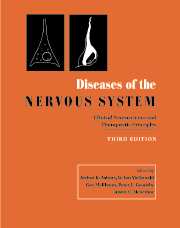Book contents
- Frontmatter
- Dedication
- Contents
- List of contributors
- Editor's preface
- PART I INTRODUCTION AND GENERAL PRINCIPLES
- PART II DISORDERS OF HIGHER FUNCTION
- PART III DISORDERS OF MOTOR CONTROL
- 31 Mechanisms of motor control
- 32 The apraxias
- 33 Parkinson's disease
- 34 Other extrapyramidal syndromes: parkinsonism-plus and other forms of secondary parkinsonism
- 35 Tremors
- 36 Myoclonus
- 37 Dystonia
- 38 Tourette syndrome
- 39 Cerebral palsy
- 40 Gait and balance disorders
- PART IV DISORDERS OF THE SPECIAL SENSES
- PART V DISORDERS OF SPINE AND SPINAL CORD
- PART VI DISORDERS OF BODY FUNCTION
- PART VII HEADACHE AND PAIN
- PART VIII NEUROMUSCULAR DISORDERS
- PART IX EPILEPSY
- PART X CEREBROVASCULAR DISORDERS
- PART XI NEOPLASTIC DISORDERS
- PART XII AUTOIMMUNE DISORDERS
- PART XIII DISORDERS OF MYELIN
- PART XIV INFECTIONS
- PART XV TRAUMA AND TOXIC DISORDERS
- PART XVI DEGENERATIVE DISORDERS
- PART XVII NEUROLOGICAL MANIFESTATIONS OF SYSTEMIC CONDITIONS
- Complete two-volume index
- Plate Section
33 - Parkinson's disease
from PART III - DISORDERS OF MOTOR CONTROL
Published online by Cambridge University Press: 05 August 2016
- Frontmatter
- Dedication
- Contents
- List of contributors
- Editor's preface
- PART I INTRODUCTION AND GENERAL PRINCIPLES
- PART II DISORDERS OF HIGHER FUNCTION
- PART III DISORDERS OF MOTOR CONTROL
- 31 Mechanisms of motor control
- 32 The apraxias
- 33 Parkinson's disease
- 34 Other extrapyramidal syndromes: parkinsonism-plus and other forms of secondary parkinsonism
- 35 Tremors
- 36 Myoclonus
- 37 Dystonia
- 38 Tourette syndrome
- 39 Cerebral palsy
- 40 Gait and balance disorders
- PART IV DISORDERS OF THE SPECIAL SENSES
- PART V DISORDERS OF SPINE AND SPINAL CORD
- PART VI DISORDERS OF BODY FUNCTION
- PART VII HEADACHE AND PAIN
- PART VIII NEUROMUSCULAR DISORDERS
- PART IX EPILEPSY
- PART X CEREBROVASCULAR DISORDERS
- PART XI NEOPLASTIC DISORDERS
- PART XII AUTOIMMUNE DISORDERS
- PART XIII DISORDERS OF MYELIN
- PART XIV INFECTIONS
- PART XV TRAUMA AND TOXIC DISORDERS
- PART XVI DEGENERATIVE DISORDERS
- PART XVII NEUROLOGICAL MANIFESTATIONS OF SYSTEMIC CONDITIONS
- Complete two-volume index
- Plate Section
Summary
Clinical neuroscience
Movement disorders may be classified as hyperkinetic, characterized by excessive, involuntary movement or hypokinetic, characterized by decreased and slowed movement. First described by James Parkinson in 1817, Parkinson's disease (PD) is the archetypal hypokinetic disorder and the second most common neurodegenerative disorder after Alzheimer's disease. Though incidence and prevalence increase with age, the total estimated incidence is 20/100000 and prevalence is 150/100000 (Schapira, 1999). In the United States, approximately one million patients have PD. The estimated societal cost tops $25 billion (Scheife et al., 2000) and is expected to rise as the population ages.
Parkinsonism: classification/clinical symptoms
‘Parkinsonism’ is a term describing syndromes combining bradykinesia, tremor, muscle rigidity, gait and balance disturbances. The term ‘idiopathic PD’ traditionally referred to patients exhibiting two or more of the cardinal signs (rest tremor, rigidity and bradykinesia) who responded to levodopa replacement therapy and did not show evidence of other neurologic disease. Given the discovery of inherited dopa-responsive PD, parkinsonian syndromes with good, sustained clinical response to dopaminergic therapy are best termed ‘primary PD’ (PPD). Infection, drugs, metabolic abnormalities, or other disease states may cause symptomatic parkinsonism. ‘Parkinson-plus’ (PD-plus) or atypical parkinsonism includes such syndromes as multiple system atrophy (MSA), progressive supranuclear palsy (PSP), Lewy body disease (LBD), the tauopathies (corticobasalganglionic degeneration and frontotemporal dementias), as well as the amyloidopathies (Alzheimer's disease with parkinsonism). These conditions typically exhibit little or no response to levodopa therapy, prominent and early gait and balance disturbance, autonomic and cognitive symptoms (Table 33.1). Table 33.2 lists signs and symptoms occuring in PPD and parkinsonian syndromes. See Chapter 34 for further discussion of the atypical syndromes.
Diagnostic criteria and clinical features for primary Parkinson's disease (PPD)
Although James Parkinson published the first description of the ‘shaking palsy’ almost 200 years ago, we still have no standardized diagnostic test for PPD. Clinical criteria for PPD vary, but most movement disorders experts agree a patient must demonstrate at least two of the three cardinal signs and experience significant, long lasting (>5 years) improvement with dopaminergic therapy (Gelb et al., 1999). With these clinical criteria and experience, neurologists’ diagnostic accuracy can approach 92% (Jankovic et al., 2000).
- Type
- Chapter
- Information
- Diseases of the Nervous SystemClinical Neuroscience and Therapeutic Principles, pp. 477 - 489Publisher: Cambridge University PressPrint publication year: 2002
- 1
- Cited by

